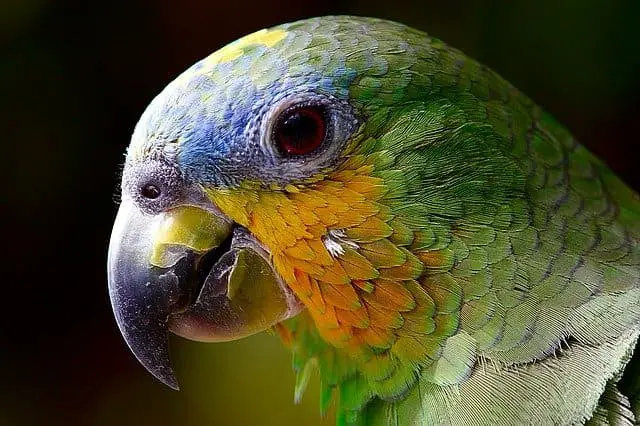Kakapo, or the owl parrot, is one of the rarest breeds of parrots in the world. This large flightless bird that thrives mostly at night belongs to the Strigopoidea family. This family is native to New Zealand’s main islands. Kakapo is the only breed of parrots that cannot fly. It has short wings with a balanced body that suits its living style of dwelling and walking on the ground.
So, Are Kakapo Endangered?
Unfortunately, yes, Kakapos are a highly endangered species, and scientists considered them a lost species in 1900 until the discovery of over 200 wild kakapos back in 1977. However, the total population kept declining through the following 2 decades. In 1995, the population of kakapo parrots began to grow again.

Where Do Kakapo Live?
Kakapos used to live in both main islands of New Zealand, they were thriving; they could thrive in any climate on New Zealand’s main islands.
But, after Polynesians arrived in New Zealand 700 years ago, they confined the natural habitat of kakapo more and more.
Currently, Kakapos live in 3 free-predator sanctuaries on codfish Island, little barrier island, and anchor island.
There is no free-predator island in New Zealand that can hold over 100 kakapos. there is a distant plan to reintroduce kakapos to the main islands of New Zealand in 2050.
Why is The Kakapo Endangered?
The extensive hunting from the Polynesian settlers, the introduced predators, and the destruction of the food forests and habitats from the European settlers. These eco changes and habitat clearances are the main reasons behind the Decline of the kakapo’s numbers in the wild.
It started 700 years ago, when the Polynesian settlers arrived in New Zealand, they found the kakapo was easy prey. They fed on it and used its feathers to make clothes. Not to mention the dogs and rats that came with them, they also preyed on kakapo.
By the Europeans’ arrival in the early 1800s, the habitat of the kakapo was already confined to the center of the northern island, and to the forested parts of the southern islands.
The Europeans also introduced new predators like cats, stoats, and 2 more species of rats. They also preyed on kakapos. not to mention the new possums and deers that depleted the food forests that kakapos used to feed on.
The elimination of forests and habitats for new European settlements sped up the demise of the kakapo wild population, which was already declining hundreds of years ago.
What Is Being Done to Save the Kakapo?
The first attempt to save the kakapos from going extinct was in 1894, when Richard Henry moved several hundreds of kakapos on a free-predator island near Fiordland.
Unfortunately, six years later, stoats arrived in the area, causing catastrophic destruction to the preserved population. and by mid-1900, the kakapo turned out to be a lost species.
Later on, and between 1943 to 1973, the New Zealand Wildlife service has launched over 60 attempts trying to find if there were any kakapo parrots are still in the wild. They only found 6 male kakapos, 1 of them died after a few months in captivity.
Between 1974 and 1977, there was a new attempt to find wild kakapos, and this time, they found 18 new wild kakapos in the Fiordland region. Still, there were no females.
Thankfully, in the same year 1977, the news came in about a newly discovered population of wild kakapo in Stewart Island/Rakiura.
The island was free from any kind of wild predators.
By the year 1980, they confirmed females to be present within the Rakiura Population.
Although this discovery, the population of kakapo kept declining until 1995, when they reached 50 individuals, this was because of the predators living in the 3 sanctuary islands mentioned earlier. They were eradicated, eventually.
How Many kakapos are Left?
Kakapo now has a total population of over 200 individuals, and luckily increasing. The increase started in 1996 after the effort of eradication of the predators in the 3 sanctuary islands.

Can a kakapo be a pet?
Currently, and because of their limited population, it’s impossible to have kakapo pets. They are a highly endangered species, and preservation efforts are yet to continue toward increasing their numbers. These efforts will continue at least to 2050, where there is a plan to move kakapo from the sanctuary islands to the mainland of New Zealand, northern and southern Islands.
But if you are asking about how the kakapo is like if he was a pet, then let me tell you that kakapos are one of the friendliest breeds of parrots. The Polynesian and European settlers used to keep kakapos as pets. The wild kakapos are also known to be friendly to the extent of approaching, climbing, and picking on humans.
It’s like they don’t feel afraid at all.
Conclusion
In conclusion, the preservation efforts are continuing to help kakapo reproduce and increase their population, aiming to reintroduce them back to their historical habitat.
Kakapos breed once every 2-4 years. Thankfully, their life span can exceed 60 years reaching the age of 80. They normally lay 1-4 eggs every time a couple reproduces.

Hello, my name is sadeq and I am obsessed about parrot And I am here to share everything about raising pet parrots and how to be good owners to your bird.






